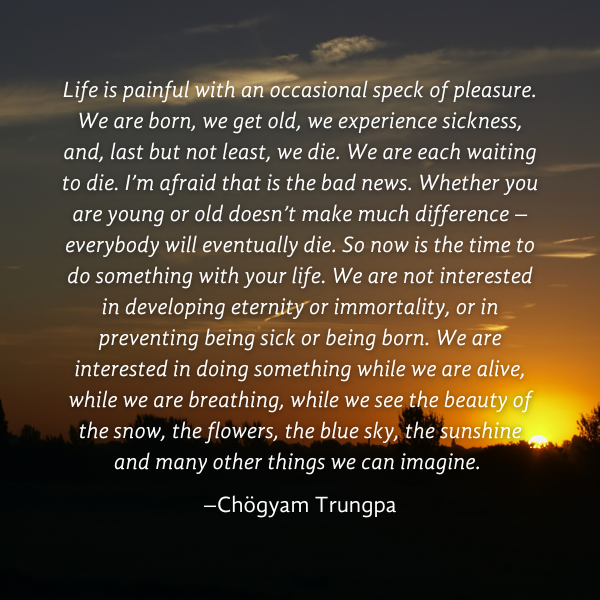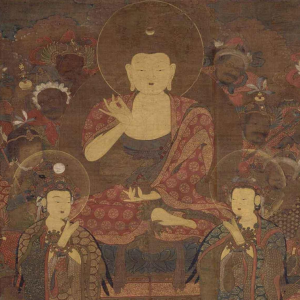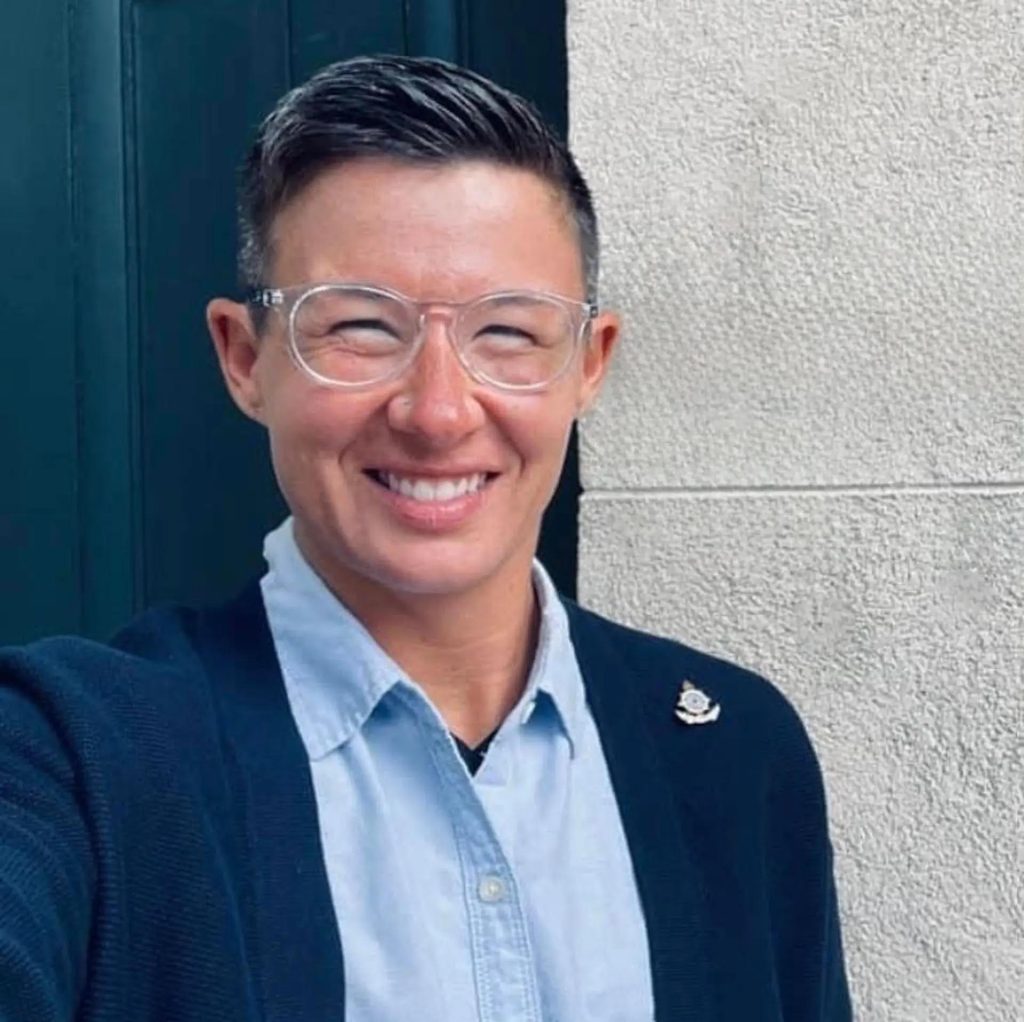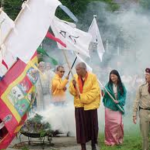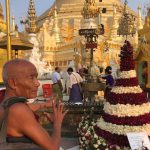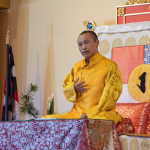Thursday
Dying & Death Classes on Shambhala Online
By Alley Smith

Death is the greatest of all teachers. –The Buddha
Shambhala Online has been offering a variety of courses on topics related to dying and death. These topics enable the sangha and outside community members to gather and think about death, engage in contemplative practices, and toil with topics such as fear, anxiety, the unknown, and how to have conversations about death.
The Shambhala community is gathering with purpose: to understand the dying process, to recognize and articulate the role of spiritual, religious and existential support, practices, and cultural norms within the modern Buddhist context. The result is tremendous openness and courage to face the inevitable and unknown in a gentle and relaxed way.
As Chögyam Trungpa Rinpoche says, Life is painful with an occasional speck of pleasure. We are born, we get old, we experience sickness, and, last but not least, we die. We are each waiting to die. I’m afraid that is the bad news. Whether you are young or old doesn’t make much difference – everybody will eventually die. So now is the time to do something with your life. We are not interested in developing eternity or immortality, or in preventing being sick or being born. We are interested in doing something while we are alive, while we are breathing, while we see the beauty of the snow, the flowers, the blue sky, the sunshine and many other things we can imagine.
While we are alive we can explore our personal belief systems about dying and death, our struggles, vulnerabilities, strong emotions, personal values, needs, and much more. Death has so much to teach us. Even as the Buddha was dying, he taught that suffering (dukkha) comes from not living in accordance with the truth of impermanence and interdependence. Death itself is a profound spiritual transmission.
Students have been gathering across the global community at Shambhala centers in Seattle, Dallas, Halifax, Los Angeles, and Philadelphia to offer support and practice advice. Communities are interested and invested in doing something while they are alive, while breathing, to be embraced by the sangha, to be met with unconditional kindness and the warmth of the Great Eastern Sun.
In the end, everything is left up to the individual. Therefore, most Buddhists do not take the truth of impermanence half-heartedly. Whether we are studying the Tibetan Book of the Dead, teachings of Amitabha Buddha, the Pure Lands, Sukhavati, Bodhichitta, the Bardos, and a vast array of teachings, we must do as many great Rinpoches and Tibetan lamas suggest. Engage in whichever practices are clearest, familiar, and most vivid on our deathbeds.
While we are alive we must be willing to face old age, sickness, and death with confidence and fearlessness. We must abandon any notion of resentment and attachment. Ask yourself, why would the Buddha say, Death is the greatest of all teachers? What can we learn from his words? In the end, as Trungpa Rinpoche says, “It’s up to you sweetheart.”
Shambhala Online would like to invite you to attend any one of these upcoming sessions in 2025:
Fear & Fearlessness: Navigating Life & Loss
March 27. During this online session, we will explore Chögyam Trungpa Rinpoche’s teachings on “Fear and Fearlessness” from the timeless classic, Shambhala: The Sacred Path of the Warrior.
The Buddha’s Discourse on Teachings to Be Given to the Sick
November 1. During this mini-retreat, we will read and explore the Buddha’s Discourse on the Teachings to Be Given to the Sick. We will examine traditional Buddhist teachings on the six senses, six sense objects, six elements, the five aggregates, and more.
Making Friends with Death & Dying: Support Group (1st Monday night of every month)
Next session April 7. Support group sessions will include a short talk, meditation practice, and an open forum to discuss personal experiences with old age, sickness, death, grief and bereavement. All are welcome. We respect your privacy. These sessions will not be recorded.
The 49 Day Ceremony: A Celebration of Life & Death
December 13. Join Chaplain Alley Smith for a 3-hour online mini-retreat as she guides participants into a deeper understanding of the 49 Day Ceremony and the common Buddhist practices and rituals that follow someone’s death – all within a modern Buddhist context.
Alley Smith (she/her) is an ordained Zen Buddhist Chaplain, scholar, researcher, and lecturer who serves at a college and university. Alley is deeply influenced by Pure Land Buddhism and Vajrayana. She has been a member of Shambhala and Zen since 1999. Alley works in the funeral industry in Vermont. She teaches a number of courses on Shambhala Online.
Entries filed under Dharma Teachings
Seeing Depression – HIGHLIGHT
In this article, Acharya Michael Greenleaf dives fearlessly into the solidity of depression and offers insight into causes, describes what is happening in our minds, and shows how meditation practice can lead to the strength and composure of true tenderness Alone It’s hard to count on ... continuePosted December 13, 2018 by michaelgreenleaf
Raising Our Children, Sharing Our World – HIGHLIGHT
Chogyam Trungpa Rinpoche holding Gesar Mukpo. Photo by James Gritz. By the Vidyadhara, Chogyam Trungpa Rinpoche Exclusive to the Shambhala Times, courtesy of Lady Diana Mukpo I have been the father of my own personal, physical children. I have also been the psychological father of many semi-grownup children, and ... continuePosted November 25, 2018 by alexandra_kalinine
Queer Dharma: The Truth of Being Queer – HIGHLIGHT
Acharya Eve Rosenthal COLUMN: Dharma Teachings by Acharya Eve Rosenthal article courtesy of Shambhala Mountain Center What is queer dharma? There are people who are queer and there is dharma, but what is queer dharma? First of all, a person who is queer identifies as someone with a sexual orientation ... continuePosted November 15, 2018 by alexandra_kalinine
Conflict in Enlightened Society – HIGHLIGHT
cherry trees along the Charles River, by Shastri Jennifer Woodhull Cape Town, South Africa Among those of us committed to building an enlightened society, there is a widespread perception that our failure to “fix” the personal conflicts that arise in our communities somehow takes us in the opposite direction ... continuePosted November 8, 2018 by alexandra_kalinine
Uncommon Advice to Heal a Broken Heart – HIGHLIGHT
guest article by Susan Piver A few years ago, I traveled across the country giving talks based on my book, The Wisdom of a Broken Heart. I drove from Boston to Victoria, B.C. and back, giving talk after talk, hearing story after story, meeting person after heartbroken ... continuePosted October 21, 2018 by alexandra_kalinine
The Magic of Lhasang – HIGHLIGHT
Lhasang with the Sakyong, Sakyong Wangmo and His Eminence Namkha Drimed Rinpoche. COLUMN: Dharma Teachings by Acharya Daniel Hessey and Walker Blaine “When we do a lhasang to bring down the magic energy of enlightenment and drala, the smoke of the lhasang is said to purify those obstacles that ... continuePosted October 9, 2018 by alexandra_kalinine
Wealth of Generosity – HIGHLIGHT
by Shastri Matthew Lyon Generosity is directly related to a feeling of abundance and confidence in our lives. On an inner level, in meditation practice, we rest the mind in the ground of basic goodness, the primordial confidence in our heart, our true nature. We can notice ... continuePosted September 10, 2018 by CGH
Fear, Anger, and Dignity – HIGHLIGHT
Reflections on the quality of dignity, especially in times of speed and aggression by Susan Firer I don’t think it would be a shock to anyone reading this, even anyone not reading this for that matter, that we are in a time of great fear and aggression. This ... continuePosted August 25, 2018 by CGH
The Three S’s – HIGHLIGHT
An opportunity to explore these three: Stillness, Silence, and Spaciousness by Brooke Binstock When the three of us (Kelly Lindsey, Marissa Knox and I) got together to talk about what to center our August retreat at Shambhala Mountain Center around, we easily settled on the theme of Stillness, Silence, ... continuePosted August 15, 2018 by CGH
The Truth of Interdependence – HIGHLIGHT
Rev. angel Kyodo williams: Why Your Liberation is Bound Up With Mine from “Meditation in the City,” the New York Shambhala Center podcast In the face of today’s political and social unrest, is it possible to create a wise, kind, and strong human society? Rev. angel Kyodo williams speaks ... continuePosted June 30, 2018 by CGH
Visit the Metta Sutta – HIGHLIGHT
Teachings on loving kindness and compassionate living by Larry Steele The Metta Sutta, the Buddha’s discourse on loving kindness, is a key teaching in the Pali Canon. It is chanted by Theravadan monks throughout the Asian southeast. During my recent visit to Myanmar, the social-activist monks Ashin Issariya and ... continuePosted June 14, 2018 by CGH
Suffering, Impermanence, Life – HIGHLIGHT
Reflecting on ways to respond to the many changes we inevitably experience by Susan Firer The world at large and our own personal worlds are always in transition. We can accept this truth or we can wish it were different – either way, the nature of reality is ... continuePosted May 17, 2018 by CGH
Warriorship in the World – HIGHLIGHT
Thoughts about the three gates (body, speech and mind), motivation, and warriorship by Susan Firer The Shambhala vision speaks of the inherent goodness and the innate wakefulness of human beings. The Shambhala teachings and our practices have the intention and power to open the door to compassionate care ... continuePosted May 5, 2018 by CGH
On Retreat – HIGHLIGHT
Reflections on the pleasures and value of retreat practice by Susan Firer Winter is such a beautiful time of year, especially in the country where the snow can stay white much longer than it can in the city. Winter is also a good time to slow down and ... continuePosted March 30, 2018 by CGH
Discurso del día de Shambhala
Sákyong, Mipham Rimpoche Discurso del día de Shambhala Centro de meditación Shambhala de Boulder 16 de febrero 2018 El Kongma Sákyong, Mipham Rimpoche: ¡Muy buenos días a todos! Tienen un hermoso aspecto, maravilloso… Quiero dar la bienvenida a todos los que se unen a nosotros en el mundo entero y en ... continuePosted March 5, 2018 by CGH
![]() RSS feed for the Dharma Teachings category
RSS feed for the Dharma Teachings category
View all posts from authors in Dharma Teachings: jillian_johnson

